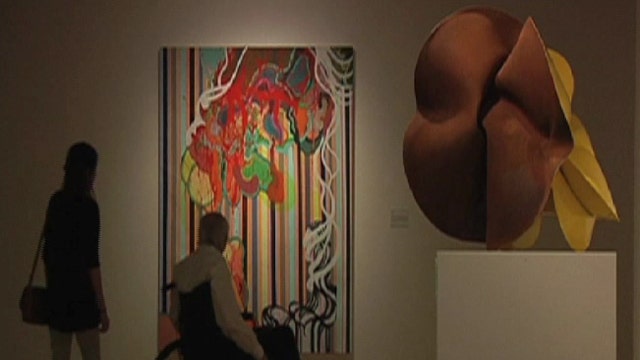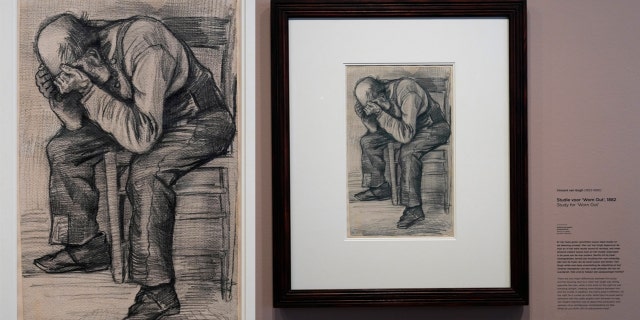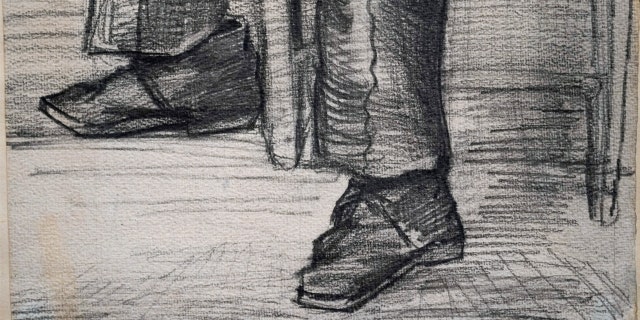‘New’ Van Gogh drawing never displayed publicly now at Amsterdam museum

Van Gogh in Vegas? Art exhibits popping up in Sin City
Matt Finn shows us how Las Vegas is adding some class with art exhibits and museums
A recently discovered work by Vincent van Gogh is now being exhibited for the first time in public at the Amsterdam museum that bears the Dutch master’s name.
“Study for ‘Worn Out’ is a preliminary study for the 1882 drawing ‘Worn Out,’ one of the most powerful figure drawings from Van Gogh’s period in The Hague,” a spokesperson from the Van Gogh Museum told Fox News.
From the style of the sketch to the materials used — a thick carpenter’s pencil and coarse watercolor paper — the drawing conforms to Van Gogh’s Hague drawings. There are even traces of damage on the back, linking the artwork to the way Van Gogh used wads of starch to attach sheets of paper to drawing boards.
Emilie Gordenker, Director of the Van Gogh Museum, told Fox News that the piece is a must-see for American tourists: “As a centre of expertise dedicated to the work of Vincent van Gogh and his contemporaries, we’re delighted with this discovery and are very happy to have made a contribution to our specialist field. It’s quite rare for a new work to be attributed to Van Gogh. We’re proud to be able to share this early drawing and its story with our visitors.”
The art comes from a time in the virtuoso’s career when he was working to improve his skills as a painter of people and portraits by drawing them, over and over again.
Detail of Study for "Worn Out", a drawing by Dutch master Vincent van Gogh, dated Nov. 1882, on public display for the first time at the Van Gogh Museum in Amsterdam, Netherlands, Thursday, Sept. 16, 2021.
(AP Photo/Peter Dejong)
The work illustrates how, as a young artist in practicing his craft, Van Gogh had to confront an uncomfortable truth: only true honing of skill leads to mastery.
The work is not for sale and its worth is immeasurable: “The Van Gogh Museum never remarks on the value of works by Van Gogh. We are not an art institution that sells artworks. We are solely interested in the art-historical value of the works.”
The piece of art shows a man – old and hairless – sitting, hunched forward on a wooden chair, his fatigued head in his hands.
The museum added: “The model for the drawing appears regularly in the work of Van Gogh, who drew the bald, elderly man more than forty times. In these drawings, the artist not only displayed his sympathy for the socially disadvantaged, but also drew attention to them, because they were to him no way inferior to the well-to-do bourgeoisie.”
Van Gogh, who had little profitmaking success while he was alive, died on July 29, 1890, of a self-inflicted gunshot wound.
The piece’s inspiration resonates with his result of working life. “In the autumn of 1882, Van Gogh tried to make some of his figure studies more expressive, to put them on a higher level. ‘Worn Out’ is one of the most convincing examples of this. The discovery of the study for this drawing allows us to closely follow the process leading up to the powerful image,” the museum noted.
Detail of Study for "Worn Out", a drawing by Dutch master Vincent van Gogh, dated Nov. 1882, on public display for the first time at the Van Gogh Museum in Amsterdam, Netherlands, Thursday, Sept. 16, 2021.
(AP Photo/Peter Dejong)
The young painter gave the drawings an English title in a bid to build a bit of name recognition and possibly even land a job at an illustrated magazine.
Even the model’s pants appear to conform to the English title — a patch is clearly visible on the right leg.
The museum said: “Worn Out is one of the strongest figure drawings from Van Gogh’s Hague period. In letters to his brother Theo and his friend Anthon van Rappard, Van Gogh described the genesis of the drawing in detail, but the studies he mentioned were yet to be discovered. The discovery of Study for ‘Worn Out’ now provides us with an intriguing insight into this working process. Especially how in the final version, upon which the lithograph was based, Van Gogh viewed his model from a different angle, had him adopt a different pose, in order to add more emotional expression. That being said, the study remains a splendid, powerful drawing by Van Gogh, which stands well alone.”
The work had been hiding in plain sight: in a private collection.
“Study for ‘Worn Out’ was submitted to the Van Gogh Museum for authentication research some time ago. The Van Gogh Museum has acknowledged the authenticity of the drawing, and drafted a report for the owner. The investigation into this drawing will be published in the visual arts journal The Burlington Magazine in October, and the drawing is on display at the museum since last Friday.”
The reasons behind the sudden discovery are a mystery. “Nothing was known of the drawing before it arrived at the museum,” the museum noted. “However, it is possible to infer from Van Gogh’s letters that two studies preceded the drawing ‘Worn Out,’ of which one was with a different model. The drawing had not been discovered, but neither had another with the same model: lots of Van Gogh’s early drawn oeuvre has simply been lost. It was therefore a wonderful surprise when one of the two studies proved not actually to have been lost, only concealed for so long.”
Detail of Study for "Worn Out", a drawing by Dutch master Vincent van Gogh, dated Nov. 1882, on public display for the first time at the Van Gogh Museum in Amsterdam, Netherlands, Thursday, Sept. 16, 2021.
(AP Photo/Peter Dejong)
“Study for ‘Worn out’” will be displayed on the first floor of the Van Gogh Museum’s permanent collection until January. Visitors will be able to view the drawing in the context of other works by Van Gogh from the same period — all of them from the Van Gogh Museum collection — including the drawing “Worn Out” itself.
After the exhibition is closed down, the drawing, including its new frame, will be returned to the owner, who is remaining anonymous.
The work is a far cry from the vibrant oil paintings of vases of sunflowers and French landscapes that eventually turned the tormented Van Gogh — after his death in 1890 — into one of the world’s most famous artists, whose works have garnered astronomical prices at auction.
Teio Meedendorp, Senior Researcher at the Van Gogh Museum, told Fox News: “Showing Study for ‘Worn Out’ in the context of these other works, offers us a special insight into Van Gogh’s working process. What’s more, the study is a very fine, powerful drawing, which stands up entirely on its own.”
The Associated Press contributed to this report.
Source: Read Full Article



